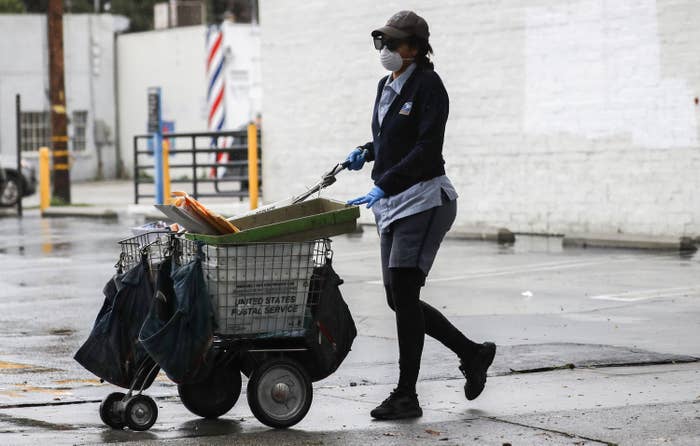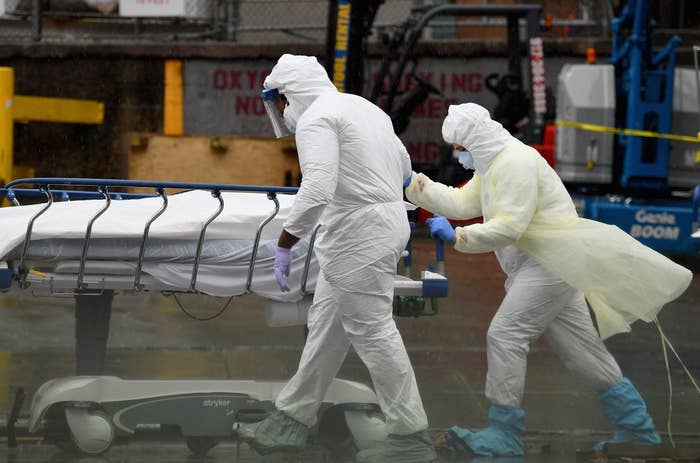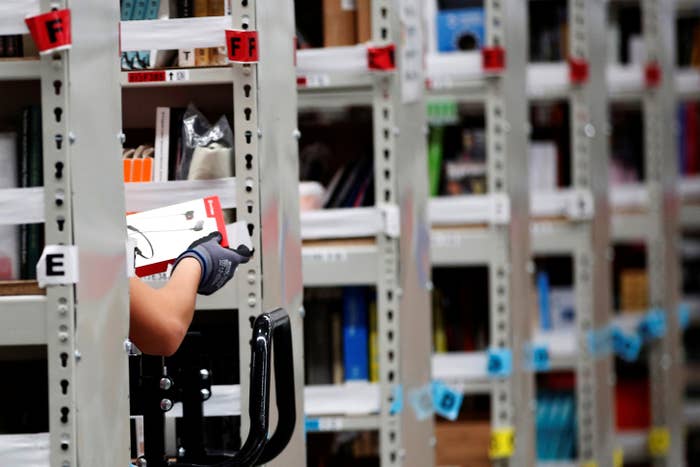“My President Is Not My God”: Some Churches Are Planning To Host Hundreds For Easter Sunday Services Despite The Coronavirus
The federal government recommends no one attend gatherings of more than 10 people, but some churches are still encouraging big congregations to attend Easter Sunday services.
Ema O'ConnorBuzzFeed News Reporter
Kadia GobaBuzzFeed News Reporter
Posted on April 11, 2020

Carlos Barria / Reuters
Pastor Tony Spell attends Sunday service at the Life Tabernacle Church in Baton Rouge, Louisiana, April 5, challenging state orders against assembling in large groups to prevent the spread of COVID-19.
The journalists at BuzzFeed News are proud to bring you trustworthy and relevant reporting about the coronavirus. To help keep this news free, become a member and sign up for our newsletter, Outbreak Today.
When he picked up the phone and heard it was a reporter on the line, Louisiana Pastor Tony Spell almost immediately began reciting the Declaration of Independence.
“We hold these truths to be self-evident, that all men are created equal, that they are endowed by their creator with certain unalienable rights, that among these are life, liberty, and the pursuit of happiness,” Spell, the leader of Life Tabernacle Church in Baton Rouge told BuzzFeed News Thursday morning over the phone.
“My government is not my creator, my president is not my God,” continued Spell, who was charged with six misdemeanors last week for continuing to hold in-person services despite the coronavirus pandemic. “The president did not give me my rights to worship God and to assemble in church, and no socialist government or godless president can take that right away.”
“The president did not give me my rights to worship God.”
While the majority of churches in the country have chosen to suspend services during the coronavirus outbreak — choosing, when they can, to host their congregations online via livestream — several churches around the country have continued to hold services. Many of them have big Easter Sunday plans, even as some church gatherings across the US have led to outbreaks among their congregants.
Glorious Way Church in Houston, Texas, plans to hold a socially distanced Easter morning service on Sunday, removing benches and using volunteer ushers to make sure family units stay six feet apart from one another, the distance recommended by the Department of Health and Human Services to help prevent spreading the virus.
Solid Rock Church, a megachurch in Ohio, has stated it will keep holding services as long as the First Amendment of the Constitution is upheld, though a notice on its website says it is limiting its services, suspending collections and communion “in a normal sense,” and that there are not a “large number of worshippers” in the facility for services. A link to “Easter @ Solid Rock” leads to an unrelated event, and the church’s calendar seems to show that the church plans on holding two services Sunday at their Lebanon (“North”) campus, as well as some “adult classes” for members of the church, including a finance class and one called “Marriage Matters.”
A woman who answered Solid Rock’s phone told BuzzFeed News she has been advised to refer all callers to its website, due to “all the bad press we’ve received” for staying open. The website has a notice saying they “agree we must all comply” with Ohio’s order, and lists ways in which the church is attempting to mitigate the spread.
However, it also insists it is the church’s responsibility to stay open, quoting this line from the New Testament: “Let us not give up the habit of meeting together, as some are doing. Instead, let us encourage one another all the more, since you see that the Day of the Lord is coming nearer. Hebrews 10:25.”

The Bridge Church@BridgeChurchRTx
Come witness this POWERFUL moment in history! We invite everyone out to come join us, as we observe Jesus' last hours, through worship and skit. Tonight at 7pm here at The Bridge Church. This is a POWERFUL skit! You don't want to miss!07:20 PM - 08 Apr 2020
Reply Retweet Favorite
The Bridge Church in Robstown, Texas, has continued to hold special services leading up to Easter, Pastor Joel Garza told BuzzFeed News over the phone Thursday, as well as its normal Sunday services. They disinfect the church before and after services, ask congregants to stay a “safe distance” from other families, and set up speakers in the parking lot for those who prefer to stay in their cars for service, but anywhere from 100 to 200 attendees have been showing up, Garza said, adding that he hopes more people come this Sunday for Easter services.
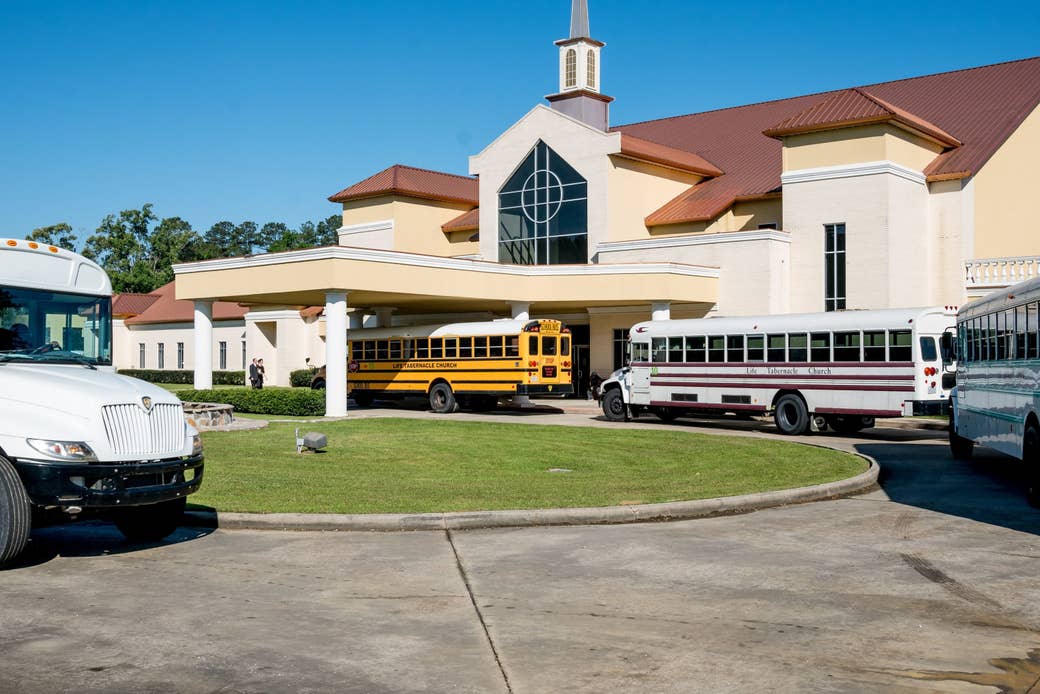
Claire Bangser / Getty Images
Buses bring churchgoers to a Palm Sunday service at the Life Tabernacle Church in Baton Rouge, Louisiana, April 5, despite statewide stay-at-home orders due to the coronavirus pandemic.
Spell, of the Life Tabernacle Church in Baton Rouge, told BuzzFeed News he is sending 27 buses out to bring congregants to his church for Easter Sunday service, and that he expects about 2,000 people to attend. The service will last all day with a rotating cast of congregants as more are bused in and out — about eight hours for the morning service and three hours in the evening, he said.
Since the beginning of the coronavirus outbreak, medical experts have advised against gatherings of more than a few people. On March 15, the Center for Disease Control and Prevention (CDC) urged against the congregating of more than 50 people. Just a few days later, President Donald Trump released his guidelines for slowing the spread of coronavirus, including avoiding “social gatherings in groups of 10 or more people.”
Many houses of worship are obeying these guidelines, and some influential religious organizations and sects, including the Church of Jesus Christ of Latter-day Saints, the Catholic Church, the US Council of Muslim Organizations, and various denominations of Judaism have closed their houses of worship or are urging services take place online.
As BuzzFeed News reported last month, a poll conducted in mid-March found that nearly a fifth of religious Americans said they were still attending in-person services. However, conditions have changed and worsened significantly since then, and some outbreaks have even occurred explicitly due to church gatherings. At least 70 attendees of a church in Sacramento, California, were diagnosed with COVID-19 last week, and in March churches in Arkansas and Illinois saw dozens of citizens fall ill after attending church events.
Several states that have issued stay-at-home orders have included exceptions for houses of worship. New York, Pennsylvania, Texas, Michigan, and California have all issued stay-at-home orders that either designate houses of worship as “essential” (exempting them from having to close) or encourage them to close but exempt them from penalties.
For example, Michigan Gov. Gretchen Whitmer banned all gatherings outside the home, but added that “a place of religious worship, when used for religious worship, is not subject to penalty" for violating the order.
Other states have directives that are not particularly clear on the guidelines for houses of worship. South Carolina and Alabama did not explicitly address houses of worship, but left them out of their list of nonessential businesses required to close. Louisiana Gov. John Bel Edwards issued an executive order in mid-March that banned gatherings of more than 50 people, but made exceptions for traveling “to-and-from” houses of worship. Ohio Gov. Mike DeWine’s order exempts houses of worship from the state’s ban on gatherings of more than 10 people, but he then tweeted a plea to religious leaders to halt in-person services.
Even with these exemptions, some religious leaders, like Spell, have flouted directives so openly that they are now facing criminal charges.
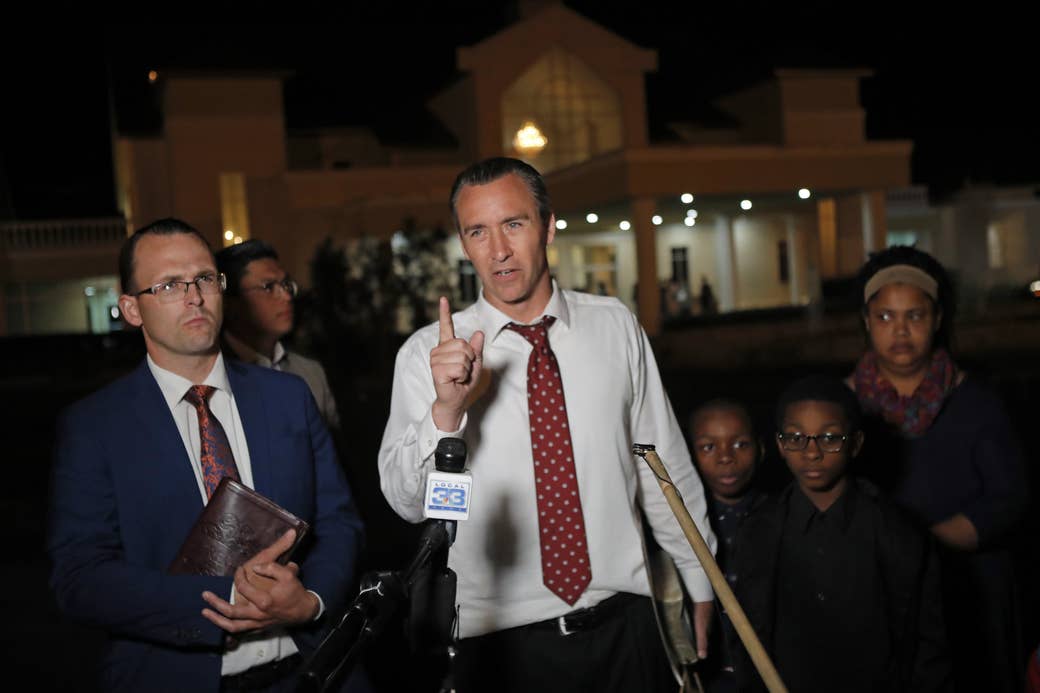
Gerald Herbert / AP
Pastor Tony Spell speaks to media after holding an evening service at the Life Tabernacle Church in Baton Rouge, Louisiana, March 31.
“Right now I have $5,000 in fines and am facing up to 900 days in jail,” Spell said Thursday, adding that his congregation continues to support him and is even growing with each service, people coming from all over the country, he said, from as far as Michigan and Minnesota. He has, at times, claimed his congregation is as big as 1,800
The Central Police Department in Baton Rouge confirmed Spell has to go to court on six counts, but said the court will decide on a fine amount and sentencing.
Asked if the department plans to break up Easter services at Life Tabernacle Church, the spokesperson told BuzzFeed, “As far as us going up in the church Sunday, unless the government puts an order out and tells the chief, our hands are tied, ma’am. We can only enforce what he’s put out. We’ve gone as far as we can go.”
Contrary to Spell’s claims, “He does not have 1,800 people in that church. Ever,” the spokesperson said. They added that the police department is on scene, monitoring the situation — but has not been invasive — and there are multiple agencies investigating the church.
In Florida, state and local governments grappled with confusing executive orders that all seem to center around megachurch pastor Rodney Howard-Browne of the River at Tampa Bay Church. Howard-Browne was arrested on March 30 after refusing to close doors in response to social distancing guidelines.
Hillsborough County in Florida issued a “safer-at-home” order on March 27 for everyone, aside from essential workers. All other residents were to leave their homes only for food, medicine, and essentials. Three days later, on April 1, Gov. Ron DeSantis followed up with a statewide executive order declaring churches “essential.” He then signed a second order that would supersede “any conflicting official action or order issued by local officials in response to COVID-19.”
Thursday afternoon, Howard-Browne posted a powerful minutelong video with the caption “The Church Shall Stand.”
“And if it is the end, then so be it. We’re willing to die for the cause of the Gospel,” Howard-Browne's voice boomed, calling the directive to close churches amid the pandemic an “insidious plan to shut the church of Jesus Christ down.” It’s still not clear if the church will open for Easter.
Pastor Jon Duncan of Cross Culture Christian Center in Lodi, California, was stopped by police before hosting in-person Palm Sunday services on April 5. The church that rented Duncan’s congregation space, Bethel Open Bible Church, had even changed the locks three weeks earlier to keep the pastor from holding services. A receptionist for Bethel Open Bible Church told BuzzFeed News Thursday that she “didn’t know” whether the group would be holding Easter Sunday services as well. The landlord did not return BuzzFeed News’ request for comment.
Other churches, like Glorious Way Church in Houston told BuzzFeed News that they are working with law enforcement to continue to hold services. Glorious Church has instituted strict social distancing rules, requiring people to wait in their cars until they are able to be ushered into the church by a volunteer and making sure every family unit is at least 6 feet apart.

Apu Gomes / Getty Images
Pastor Rob McCoy leads a communion ceremony after an online Palm Sunday service at the Godspeak Calvary Chapel sanctuary in Thousand Oaks, California, April 5.
In a phone call Thursday, Glorious Way Church Associate Pastor James Buntrock said that he has even hired law enforcement to be present at services to protect his congregation from media covering the church, or in case any “activist type people” try to show up to spread COVID-19 among the church attendees.
“Nobody has threatened us directly here,” Buntrock said, adding that they haven’t had any problems with members of the press either: “But I've heard rumors of those possibilities,” he said, “so I just wanted to be prepared.”
Texas’ stay-at-home order explicitly labeled houses of worship “essential services,” and some churches, like Glorious Way and the Bridge Church are taking that very seriously.
“We as essential organizations need to show up right now.”
Posted on April 11, 2020

Carlos Barria / Reuters
Pastor Tony Spell attends Sunday service at the Life Tabernacle Church in Baton Rouge, Louisiana, April 5, challenging state orders against assembling in large groups to prevent the spread of COVID-19.
The journalists at BuzzFeed News are proud to bring you trustworthy and relevant reporting about the coronavirus. To help keep this news free, become a member and sign up for our newsletter, Outbreak Today.
When he picked up the phone and heard it was a reporter on the line, Louisiana Pastor Tony Spell almost immediately began reciting the Declaration of Independence.
“We hold these truths to be self-evident, that all men are created equal, that they are endowed by their creator with certain unalienable rights, that among these are life, liberty, and the pursuit of happiness,” Spell, the leader of Life Tabernacle Church in Baton Rouge told BuzzFeed News Thursday morning over the phone.
“My government is not my creator, my president is not my God,” continued Spell, who was charged with six misdemeanors last week for continuing to hold in-person services despite the coronavirus pandemic. “The president did not give me my rights to worship God and to assemble in church, and no socialist government or godless president can take that right away.”
“The president did not give me my rights to worship God.”
While the majority of churches in the country have chosen to suspend services during the coronavirus outbreak — choosing, when they can, to host their congregations online via livestream — several churches around the country have continued to hold services. Many of them have big Easter Sunday plans, even as some church gatherings across the US have led to outbreaks among their congregants.
Glorious Way Church in Houston, Texas, plans to hold a socially distanced Easter morning service on Sunday, removing benches and using volunteer ushers to make sure family units stay six feet apart from one another, the distance recommended by the Department of Health and Human Services to help prevent spreading the virus.
Solid Rock Church, a megachurch in Ohio, has stated it will keep holding services as long as the First Amendment of the Constitution is upheld, though a notice on its website says it is limiting its services, suspending collections and communion “in a normal sense,” and that there are not a “large number of worshippers” in the facility for services. A link to “Easter @ Solid Rock” leads to an unrelated event, and the church’s calendar seems to show that the church plans on holding two services Sunday at their Lebanon (“North”) campus, as well as some “adult classes” for members of the church, including a finance class and one called “Marriage Matters.”
A woman who answered Solid Rock’s phone told BuzzFeed News she has been advised to refer all callers to its website, due to “all the bad press we’ve received” for staying open. The website has a notice saying they “agree we must all comply” with Ohio’s order, and lists ways in which the church is attempting to mitigate the spread.
However, it also insists it is the church’s responsibility to stay open, quoting this line from the New Testament: “Let us not give up the habit of meeting together, as some are doing. Instead, let us encourage one another all the more, since you see that the Day of the Lord is coming nearer. Hebrews 10:25.”

The Bridge Church@BridgeChurchRTx
Come witness this POWERFUL moment in history! We invite everyone out to come join us, as we observe Jesus' last hours, through worship and skit. Tonight at 7pm here at The Bridge Church. This is a POWERFUL skit! You don't want to miss!07:20 PM - 08 Apr 2020
Reply Retweet Favorite
The Bridge Church in Robstown, Texas, has continued to hold special services leading up to Easter, Pastor Joel Garza told BuzzFeed News over the phone Thursday, as well as its normal Sunday services. They disinfect the church before and after services, ask congregants to stay a “safe distance” from other families, and set up speakers in the parking lot for those who prefer to stay in their cars for service, but anywhere from 100 to 200 attendees have been showing up, Garza said, adding that he hopes more people come this Sunday for Easter services.

Claire Bangser / Getty Images
Buses bring churchgoers to a Palm Sunday service at the Life Tabernacle Church in Baton Rouge, Louisiana, April 5, despite statewide stay-at-home orders due to the coronavirus pandemic.
Spell, of the Life Tabernacle Church in Baton Rouge, told BuzzFeed News he is sending 27 buses out to bring congregants to his church for Easter Sunday service, and that he expects about 2,000 people to attend. The service will last all day with a rotating cast of congregants as more are bused in and out — about eight hours for the morning service and three hours in the evening, he said.
Since the beginning of the coronavirus outbreak, medical experts have advised against gatherings of more than a few people. On March 15, the Center for Disease Control and Prevention (CDC) urged against the congregating of more than 50 people. Just a few days later, President Donald Trump released his guidelines for slowing the spread of coronavirus, including avoiding “social gatherings in groups of 10 or more people.”
Many houses of worship are obeying these guidelines, and some influential religious organizations and sects, including the Church of Jesus Christ of Latter-day Saints, the Catholic Church, the US Council of Muslim Organizations, and various denominations of Judaism have closed their houses of worship or are urging services take place online.
As BuzzFeed News reported last month, a poll conducted in mid-March found that nearly a fifth of religious Americans said they were still attending in-person services. However, conditions have changed and worsened significantly since then, and some outbreaks have even occurred explicitly due to church gatherings. At least 70 attendees of a church in Sacramento, California, were diagnosed with COVID-19 last week, and in March churches in Arkansas and Illinois saw dozens of citizens fall ill after attending church events.
Several states that have issued stay-at-home orders have included exceptions for houses of worship. New York, Pennsylvania, Texas, Michigan, and California have all issued stay-at-home orders that either designate houses of worship as “essential” (exempting them from having to close) or encourage them to close but exempt them from penalties.
For example, Michigan Gov. Gretchen Whitmer banned all gatherings outside the home, but added that “a place of religious worship, when used for religious worship, is not subject to penalty" for violating the order.
Other states have directives that are not particularly clear on the guidelines for houses of worship. South Carolina and Alabama did not explicitly address houses of worship, but left them out of their list of nonessential businesses required to close. Louisiana Gov. John Bel Edwards issued an executive order in mid-March that banned gatherings of more than 50 people, but made exceptions for traveling “to-and-from” houses of worship. Ohio Gov. Mike DeWine’s order exempts houses of worship from the state’s ban on gatherings of more than 10 people, but he then tweeted a plea to religious leaders to halt in-person services.
Even with these exemptions, some religious leaders, like Spell, have flouted directives so openly that they are now facing criminal charges.

Gerald Herbert / AP
Pastor Tony Spell speaks to media after holding an evening service at the Life Tabernacle Church in Baton Rouge, Louisiana, March 31.
“Right now I have $5,000 in fines and am facing up to 900 days in jail,” Spell said Thursday, adding that his congregation continues to support him and is even growing with each service, people coming from all over the country, he said, from as far as Michigan and Minnesota. He has, at times, claimed his congregation is as big as 1,800
The Central Police Department in Baton Rouge confirmed Spell has to go to court on six counts, but said the court will decide on a fine amount and sentencing.
Asked if the department plans to break up Easter services at Life Tabernacle Church, the spokesperson told BuzzFeed, “As far as us going up in the church Sunday, unless the government puts an order out and tells the chief, our hands are tied, ma’am. We can only enforce what he’s put out. We’ve gone as far as we can go.”
Contrary to Spell’s claims, “He does not have 1,800 people in that church. Ever,” the spokesperson said. They added that the police department is on scene, monitoring the situation — but has not been invasive — and there are multiple agencies investigating the church.
In Florida, state and local governments grappled with confusing executive orders that all seem to center around megachurch pastor Rodney Howard-Browne of the River at Tampa Bay Church. Howard-Browne was arrested on March 30 after refusing to close doors in response to social distancing guidelines.
Hillsborough County in Florida issued a “safer-at-home” order on March 27 for everyone, aside from essential workers. All other residents were to leave their homes only for food, medicine, and essentials. Three days later, on April 1, Gov. Ron DeSantis followed up with a statewide executive order declaring churches “essential.” He then signed a second order that would supersede “any conflicting official action or order issued by local officials in response to COVID-19.”
Thursday afternoon, Howard-Browne posted a powerful minutelong video with the caption “The Church Shall Stand.”
“And if it is the end, then so be it. We’re willing to die for the cause of the Gospel,” Howard-Browne's voice boomed, calling the directive to close churches amid the pandemic an “insidious plan to shut the church of Jesus Christ down.” It’s still not clear if the church will open for Easter.
Pastor Jon Duncan of Cross Culture Christian Center in Lodi, California, was stopped by police before hosting in-person Palm Sunday services on April 5. The church that rented Duncan’s congregation space, Bethel Open Bible Church, had even changed the locks three weeks earlier to keep the pastor from holding services. A receptionist for Bethel Open Bible Church told BuzzFeed News Thursday that she “didn’t know” whether the group would be holding Easter Sunday services as well. The landlord did not return BuzzFeed News’ request for comment.
Other churches, like Glorious Way Church in Houston told BuzzFeed News that they are working with law enforcement to continue to hold services. Glorious Church has instituted strict social distancing rules, requiring people to wait in their cars until they are able to be ushered into the church by a volunteer and making sure every family unit is at least 6 feet apart.

Apu Gomes / Getty Images
Pastor Rob McCoy leads a communion ceremony after an online Palm Sunday service at the Godspeak Calvary Chapel sanctuary in Thousand Oaks, California, April 5.
In a phone call Thursday, Glorious Way Church Associate Pastor James Buntrock said that he has even hired law enforcement to be present at services to protect his congregation from media covering the church, or in case any “activist type people” try to show up to spread COVID-19 among the church attendees.
“Nobody has threatened us directly here,” Buntrock said, adding that they haven’t had any problems with members of the press either: “But I've heard rumors of those possibilities,” he said, “so I just wanted to be prepared.”
Texas’ stay-at-home order explicitly labeled houses of worship “essential services,” and some churches, like Glorious Way and the Bridge Church are taking that very seriously.
“We as essential organizations need to show up right now.”
“We as essential organizations need to show up right now. If nurses and doctors, or police officers and firefighters, didn’t show up, it would be considered dishonorable,” Bridge Church leader Joel Garza told BuzzFeed News. “Yet churches, for whatever reason, seem to feel like it's okay not to show up when our world needs us the most.”
Garza even went as far as to say that he believed attending services would help people fight off coronavirus.
“Right now people are staying at home, depressed, it weakens your immune system, and they're most susceptible to disease through depression,” Garza said. “But if they come to church, they're encouraged, they're joyful, their immune system receives like a B-12, and they're able to go do better fighting off any kind of infirmities.”
American Psychological Association Director of Clinical Research and Quality Vaile Wright told BuzzFeed News Friday that there was “certainly no evidence” to suggest that attending church could boost your immune system, and that even recommending a distance of 6 feet between congregants was still in violation of the CDC’s recommendations.
“Long-term stress can suppress the immune system and that can in turn lead to illness, and we do know social contact is a way to buffer stress. However, the benefit that can come from that social contact does not have to be face to face,” Wright said. “It’s important that we come together during these times of worship, but you have to balance that with the public health imperative to stay physically apart.”
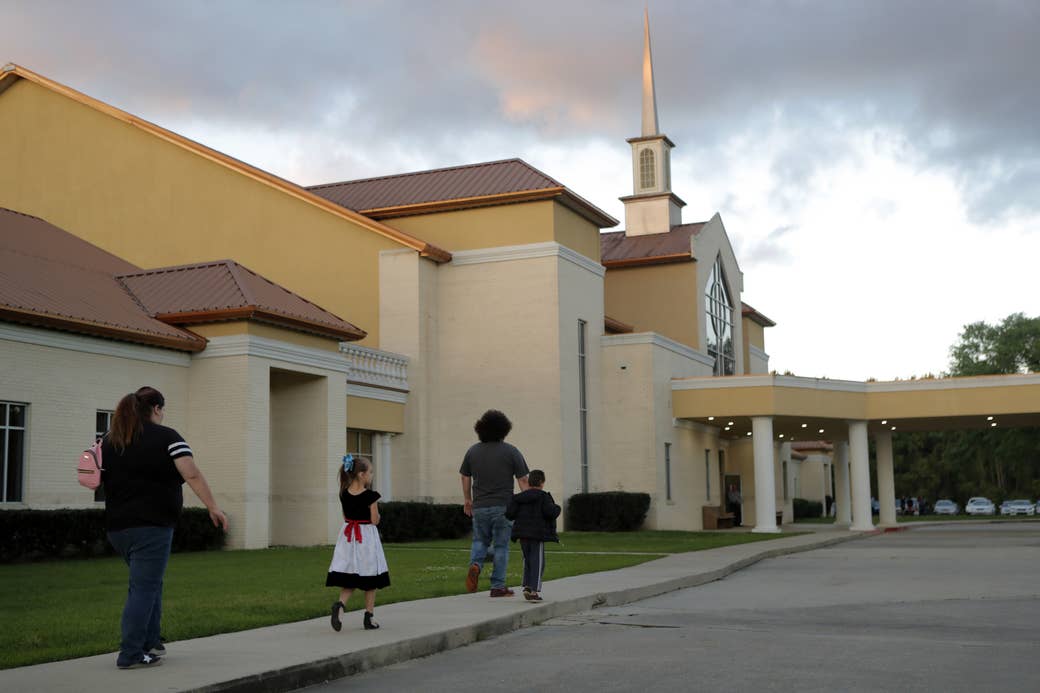
Gerald Herbert / AP
Congregants arrive for evening service at the Life Tabernacle Church in Baton Rouge, Louisiana.
Staff who spoke to BuzzFeed News from each of the churches choosing to remain open for Easter said they had received angry, and even vulgar and explicit, complaints about their choice, but that they see the pandemic as even more of a reason for them to stay open.
The pastors also argued that they are providing concrete support for people affected by the pandemic through their charity. Many churches that have remained open have also been gathering and distributing food and essentials to people whose income or meal access has been affected by coronavirus closures.
“I appreciate what doctors and nurses are doing. We pray for them. They are right in the middle of this — they're being separated from their families. It's horrible,” Glorious Way’s pastor Buntrock said.
“But the answer to this is not an entirely natural answer,” he continued. “We've got to bring God into this. He is the answer to this. I want that message to get out. So that's why we're staying open.” ●
Garza even went as far as to say that he believed attending services would help people fight off coronavirus.
“Right now people are staying at home, depressed, it weakens your immune system, and they're most susceptible to disease through depression,” Garza said. “But if they come to church, they're encouraged, they're joyful, their immune system receives like a B-12, and they're able to go do better fighting off any kind of infirmities.”
American Psychological Association Director of Clinical Research and Quality Vaile Wright told BuzzFeed News Friday that there was “certainly no evidence” to suggest that attending church could boost your immune system, and that even recommending a distance of 6 feet between congregants was still in violation of the CDC’s recommendations.
“Long-term stress can suppress the immune system and that can in turn lead to illness, and we do know social contact is a way to buffer stress. However, the benefit that can come from that social contact does not have to be face to face,” Wright said. “It’s important that we come together during these times of worship, but you have to balance that with the public health imperative to stay physically apart.”

Gerald Herbert / AP
Congregants arrive for evening service at the Life Tabernacle Church in Baton Rouge, Louisiana.
Staff who spoke to BuzzFeed News from each of the churches choosing to remain open for Easter said they had received angry, and even vulgar and explicit, complaints about their choice, but that they see the pandemic as even more of a reason for them to stay open.
The pastors also argued that they are providing concrete support for people affected by the pandemic through their charity. Many churches that have remained open have also been gathering and distributing food and essentials to people whose income or meal access has been affected by coronavirus closures.
“I appreciate what doctors and nurses are doing. We pray for them. They are right in the middle of this — they're being separated from their families. It's horrible,” Glorious Way’s pastor Buntrock said.
“But the answer to this is not an entirely natural answer,” he continued. “We've got to bring God into this. He is the answer to this. I want that message to get out. So that's why we're staying open.” ●



